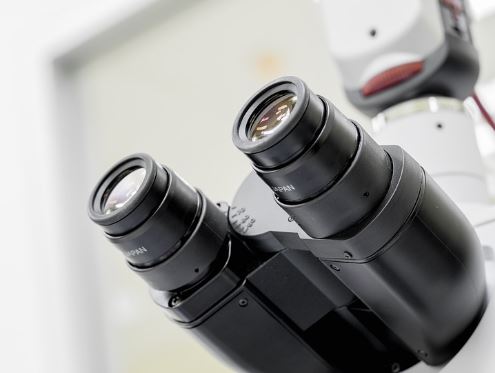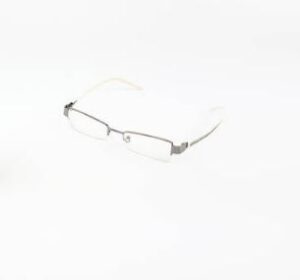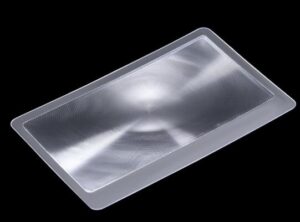Microscope camera includes software that allows you to view a live image from the microscope on the computer. Can we use a phone camera as a microscope? Yes, we can use our phone camera as a microscope. Besides, how to choose? The benefits of microscope cameras and elements to buy are introduced in this article.
Table of Contents
What is a Microscope Camera?
Microscope camera includes software that allows you to view a live image from the microscope on the computer. The software can be used to record images and videos, as well as to measure the images that are recorded.
Can We Use a Phone Camera as a Microscope?
Your smartphone camera can now function as a microscope camera.
A clip-on filter that can transform a camera phone into a microscope has been created by researchers from RMIT University and the University of Adelaide. Plus, the designers are making the design open source and free to use, so all you need to own is a 3D printer.
You can use the device to view specimens as small as 1/200th of a millimeter, including animal and plant cells, blood cells, and cell nuclei. This technology could revolutionize field diagnostics and medical care in remote areas in addition to allowing you to peek at your friendly neighborhood microbes.
“Our mobile microscope can be used as an inexpensive and portable tool for all types of on-site or remote area monitoring,” said The ARC Centre of Excellence for Nanoscale BioPhotonics (CNBP)’s principal developer and research fellow Dr. Antony Orth.
How to a Two-pronged Approach?
In order to solve two issues that restrict the use of the current mobile phone microscope cameras, the designers took a two-pronged approach to their design process.
“Ideally a phone microscope should take advantage of the integrated flash found in nearly every modern mobile, avoiding the need for external lighting and power,” Orth said.
“Additionally, it ought to be lightweight and simple to put together. This design ethos served as our inspiration as we created this add-on clip.”
According to the researchers’ paper, published in Scientific Reports, the clip-on resembles modern optical microscope designs. The objective lens is a lens that is placed inside a notch on the clip, and the tube lens is the camera on the phone. Even a slight magnification can produce a microscopic resolution on most mobile phones due to their small pixel sizes (1.22 µm for the iPhone 6 s, for example).
The team came up with a design that relies on the phone’s built-in light and does not require an external light source to address the lighting issue, which sets it apart from other similar devices on the market.
“We’ve designed a simple mobile phone microscope camera that takes advantage of the integrated illumination available with nearly all smartphone cameras,” Orth said.
“While the phone itself has a perfectly good flash, almost all other phone-based microscopes rely on externally powered light sources.”
Internal illumination tunnels that direct light from the camera flash to illuminate the sample from behind make this possible.
Due to the device’s dual brightfield and darkfield microscopy capabilities, it can display specimens on either a light or dark background, depending on the level of visibility required.
“Having both capabilities in such a small device is extremely beneficial and increases the range of activity that the microscope can be successfully used for,” Orth said.
The design is simplified by using the camera’s own light source, which also makes it more portable and user-friendly.
“These other systems can become unexpectedly complicated, large, and challenging to assemble when external LEDs and power sources are used. The beauty of our design is that the microscope is useable after one simple assembly step and requires no additional illumination optics, significantly reducing the cost and complexity of assembly,” Orth said.
What Field Help?
Due to recent significant advancements in a mobile phone such as microscope camera imaging technology, it is now a viable alternative for use in places where conventional equipment may not be available. Orth expressed his hope that this device could be used to advance medical care and diagnostics in rural and developing nations. Photos of zooplankton taken with a clip-on microscope that was 3D printed. (Photo: RMIT/CNBP)
“Powerful microscopes can be few and far between in some regions,” he said.
“They are frequently absent from rural or smaller communities and are only found in densely populated areas. However, their use in these locations can be crucial for determining the quality of drinking water, as well as for the analysis of blood samples for parasites or the diagnosis of diseases like malaria.”
Orth and his associates have already put this iteration of the phone microscope through its paces in a variety of settings, and it has been successful in visualizing zooplankton and cell cultures.
What Options Are There for Microscopes Cameras?
You will need a camera or the ability to attach one if you want to share pictures of your microscopic findings. There are some microscopes with a camera. And for others, you can use a DSLR camera adapter, a phone adapter, or an eyepiece camera. The cameras in this article work with the manufacturers I previously discussed in this post about the best compound microscopes. Find out which microscope camera option is best for you by reading on.
Phone Mount
The simplest and most adaptable way to attach a camera to your microscope is to simply use a phone mount to fasten your smartphone to the device.
While some smartphone mounts, like the Swift phone adapter, are produced by particular microscope brands, others are made to be universal so they work with a variety of microscope brands.
Phone mounts:
- Swift phone adapter
- Universal phone adapter
Eyepiece Camer
A camera known as an eyepiece camera is a microscope camera that is directly attached to the microscope eyepiece and communicates with a computer via USB without the use of any adapters. Eyepiece cameras for AmScope, Swift, and OMAX compound microscopes are available separately or as part of a compound microscope like the AmScope.
Eyepiece cameras:
- AmScope eyepiece camera
- Swift eyepiece camera
- OMAX eyepiece camera

Charge-coupled Device (CCD) Camera
Because these cameras typically offer higher megapixels (MP) than eyepiece cameras at 10 MP and above, charge-coupled devices or CCD cameras for microscopes provide a higher quality image. These use USB to connect to a computer.
An adapter for the C-mount on microscopes is required to attach a CCD camera. A c-mount adapter is typically included with trinocular microscopes. You must, however, buy a binocular microscope as a microscope camera.
CCD cameras:
- AmScope
- Swift
- OMAX
Digital SLR (DSLR) Camer
A digital SLR (DSLR) camera, like one made by Canon or Nikon, is the best tool for taking the highest-quality pictures and videos.
They need an SLR adapter for the camera and a microscope-specific C-mount adapter to be connected to the microscope. Trinocular microscopes, but not binocular ones, will be included with the C-mount. However, due to their weight and additional adapter, it is best to use a DSLR camera with trinocular microscopes.
DSLR camera adapters:
- Canon camera microscope adapter
- Nikon camera microscope adapter
The Canon Rebel T7 is the DSLR that I advise and own. It is a top-notch DSLR camera that is very user-friendly for beginners. You can use it for things other than taking pictures with your microscope because it is a DSLR as microscope camera.
What Are The Benefits of Attaching a Microscope Camera?
Three benefits are as follows.
Allows You to Take Photos and Videos
The ability to take pictures so you can share your findings with others is a clear advantage of attaching a microscope camera. However, you can also record videos, which is a great way to capture microorganisms since they are such dynamic beings. Pond microbes move in fascinating ways that are difficult for photographs to capture.
Helps With Eye Strain
It doesn’t take long for your eyes to start to hurt when you spend any amount of time looking through a microscope. So, regrettably, you might discover that you can’t use your beloved microscope camera for extended periods of time without experiencing eye fatigue. Instead of straining your eyes by looking through the microscope eyepiece, however, you can attach a camera and look at the display of your phone or computer.
Improves Ergonomics
You slouch and adopt a bad posture as a result of peering through the microscope eyepiece. However, if there is a camera attached, you can look at the phone or computer screen while maintaining a straight posture. Putting down the microscope, please.
How Do You Attach a Camera to a Microscope?
To a trinocular or binocular microscope head, a microscope camera can be attached. However, trinocular microscopes have an additional ocular tube with a special attachment point for a microscope camera or DSLR.
The head of a binocular microscope can be equipped with a camera. But if the camera is too heavy and knocks the microscope over, you might have problems. Therefore, keep weight in mind and be aware that you might need to provide support for a heavier camera.
You will need to buy a phone mount for phone cameras to stabilize your smartphone and make it simple to take pictures through the eyepiece.
Without an adapter, eyepiece cameras can be attached to the microscope eyepiece directly.
If your microscope does not come with a c-mount adapter, you will likely need to buy one in order to attach charge-coupled device (CCD) cameras and DSLR cameras. An SLR adapter is also necessary for DSLR cameras.
How To Choose Your Microscope Camera?
By enabling you to share what you learn about the microbial world, getting a microscope camera can improve your microscopy experience. Additionally, if you’re a teacher, a camera on your microscope will allow you to project the image of what your class can see onto a computer screen while showing them what you can see through the microscope.
You must think carefully about what is most important for your objectives. A phone adapter could be the best option if you want to save money and have an easy way to take pictures. However, an eyepiece camera or a CCD camera is required if you’d prefer to view the microscope view on a computer screen. Choose a DSLR camera if you want to capture the best possible images and videos. Make sure you have the proper adapters for your DSLR and CCD cameras.
What to Consider When Choosing a Microscope Camera?
There are two key elements you should consider when buying a microscope camera.
Key Elements of Image Quality
Selecting the proper optics and camera for your application is the most crucial step in ensuring successful microscopic imaging. An sCMOS (scientific complementary metal-oxide semiconductor) camera, for instance, is a great option for the majority of fluorescence imaging but is inappropriate for long-exposure applications, like bioluminescence imaging. The key factors to think about in terms of a microscope camera’s advantages and capabilities depending on the application are described in the sections that follow.
Image Processing and Functional Imaging
Image processing can sometimes be used in applications to overcome conventional optical and physical constraints. An image can be acquired with a thick sample using the extended focus image (EFI) technique (Fig. 6), with stereo microscopes, in particular. Industrial inspection frequently employs high dynamic range (HDR) imaging due to its capacity to record reflective samples (Fig. 7). The SNR of fluorescence live images can be improved using a number of methods. As an illustration, automatic multi-frame averaging, which only works when the microscope stage is stationary, is one method to achieve both a high SNR and a quick frame rate while minimizing phototoxic damage to your sample.
Microscope camera includes software that allows you to view a live image from the microscope on the computer. You can use a microscope camera. There are four options for microscope cameras, but you should understand the key elements before buying a microscope camera.


